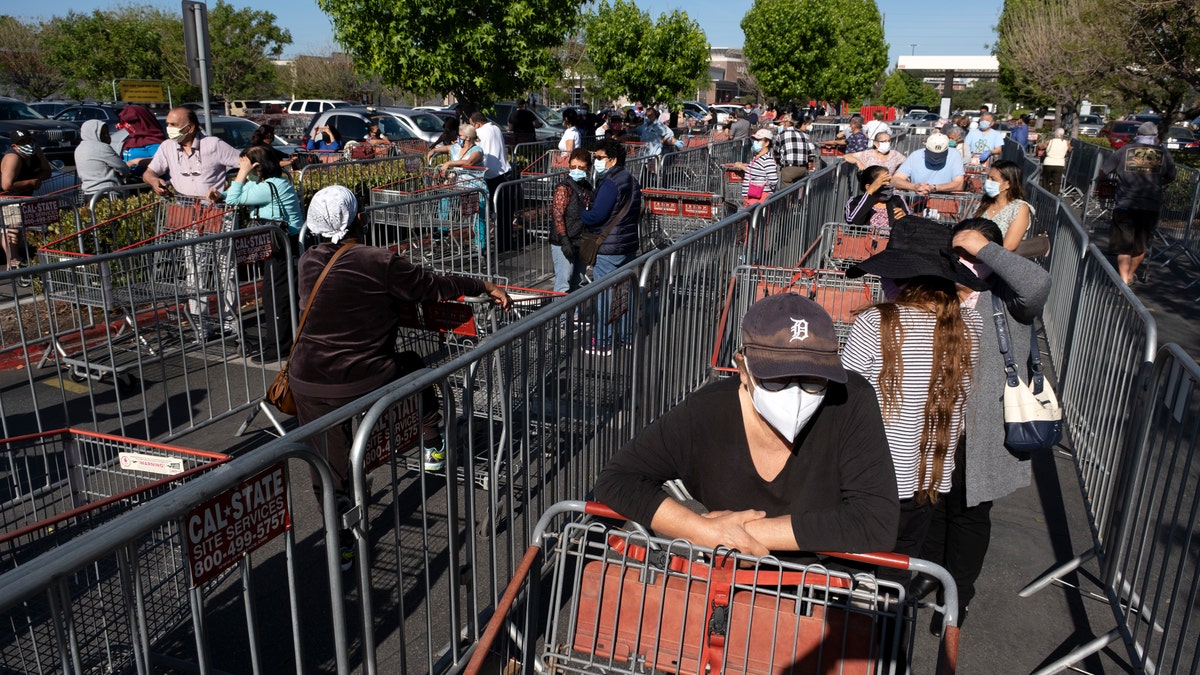Fox News Flash top headlines for May 27
Fox News Flash top headlines are here. Check out what's clicking on Foxnews.com.
Get all the latest news on coronavirus and more delivered daily to your inbox. Sign up here.
When inside, it might be a good idea to take a few more steps back.
Experts on Tuesday said they believe the six-feet of distance recommended by the World Health Organization (WHO) may not be enough to limit the transmission of COVID-19.
In a perspective article published in the journal Science, three experts wrote that aerosol particles can accumulate and remain infectious in indoor air for hours, while being easily inhaled deep into the lungs.
WEARING A SURGICAL MASK CAN REDUCE CORONAVIRUS TRANSMISSION BY UP TO 75 PERCENT, STUDY SAYS

Customers wearing protective masks from the coronavirus and keeping social distancing space line up to enter a Costco Wholesale store in the Van Nuys section of Los Angeles, Saturday, May 16, 2020. (AP Photo/Richard Vogel)
"Increasing evidence for SARS-CoV-2 suggests the 6 ft WHO recommendation is likely not enough under many indoor conditions where aerosols can remain airborne for hours, accumulate over time, and follow air flows over distances further than 6 ft," they said.
Chia Wang of National Sun Yat-sen University in Taiwan, as well as Kimberly Prather and Dr. Robert Schooley of the University of California, San Diego, said that a large proportion of the COVID-19 spread appears to be occurring through the airborne transmission of aerosols. They added the transmission was produced by asymptomatic individuals during breathing and speaking.
On Tuesday, the experts said that for society to resume as normal, measures must be implemented to reduce aerosol transmission, which includes the universal wearing of masks -- in addition to widespread testing. They believe both practices could help identify and isolate those infected asymptomatic individuals.
TEXAS BAR OWNER BANS CUSTOMERS FROM WEARING CORONAVIRUS MASKS INSIDE
"It is particularly important to wear masks in locations with conditions that can accumulate high concentrations of viruses, such as health care settings, airplanes, restaurants, and other crowded places with reduced ventilation," they added.
The perspective article stated that countries -- like Taiwan, Hong Kong, Singapore, and South Korea -- have implemented universal masking and were the most effective in reducing the spread of COVID-19.
The six feet of social distancing guidelines by the WHO is based on studies of respiratory droplets in the 1930s. However, technology didn't exist at the time for detecting tiny aerosol particles, the experts stated.
Smaller aerosols will evaporate faster than they can settle, they added. Because of that, they can be affected by air currents, which can transport them over long distances and cause them to stay in the air for hours.
“A lot of the evidence has been pointing to aerosol transmission of respiratory viruses,” Prather told WebMD. “This particular virus, a lot of evidence is mounting.”
CLICK HERE FOR MORE CORONAVIRUS COVERAGE
This month, a study by scientists in Hong Kong found that using surgical masks could reduce the rate of non-contact transmission through respiratory droplets or airborne particles by up to 75 percent.

